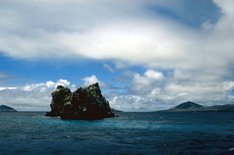Reef
|
|
- For other uses, see Reef (disambiguation).
In nautical parlance, a reef is a rock, sandbar, or other feature beneath the surface of the water, but shallow enough to be a hazard to ships (see also shoal). Many reefs result from abiotic processes—deposition of sand, wave erosion planning down rock outcrops, and other natural processes—but the best-known reefs are those of tropical waters developed through biotic processes dominated by corals and calcareous algae.
Although "reefs" can be created artificially either by special construction or through deliberately sinking ships, these are not really reefs, as it is seldom the case that an artificial obstruction would be created that is a hazard to shiping. These are structures created to enhance physical complexity on generally featureless sand bottoms in order to attract a diverse assemblage of organsims, especially fishes. Thus, "artificial reef" is a misnomer.
Biotic reef types
There are a number of biotic reef types, including oyster reefs, but the most massive and widely distributed are tropical coral reefs. Although corals are major contributors to the framework and bulk material comprising a coral reef, the organisms most responsible for reef growth against the constant assault from ocean waves are calcarous algae, especially, although not entirely, species of red algae.
External link
- NOAA Photo Library (http://www.photolib.noaa.gov/reef/)da:Rev

